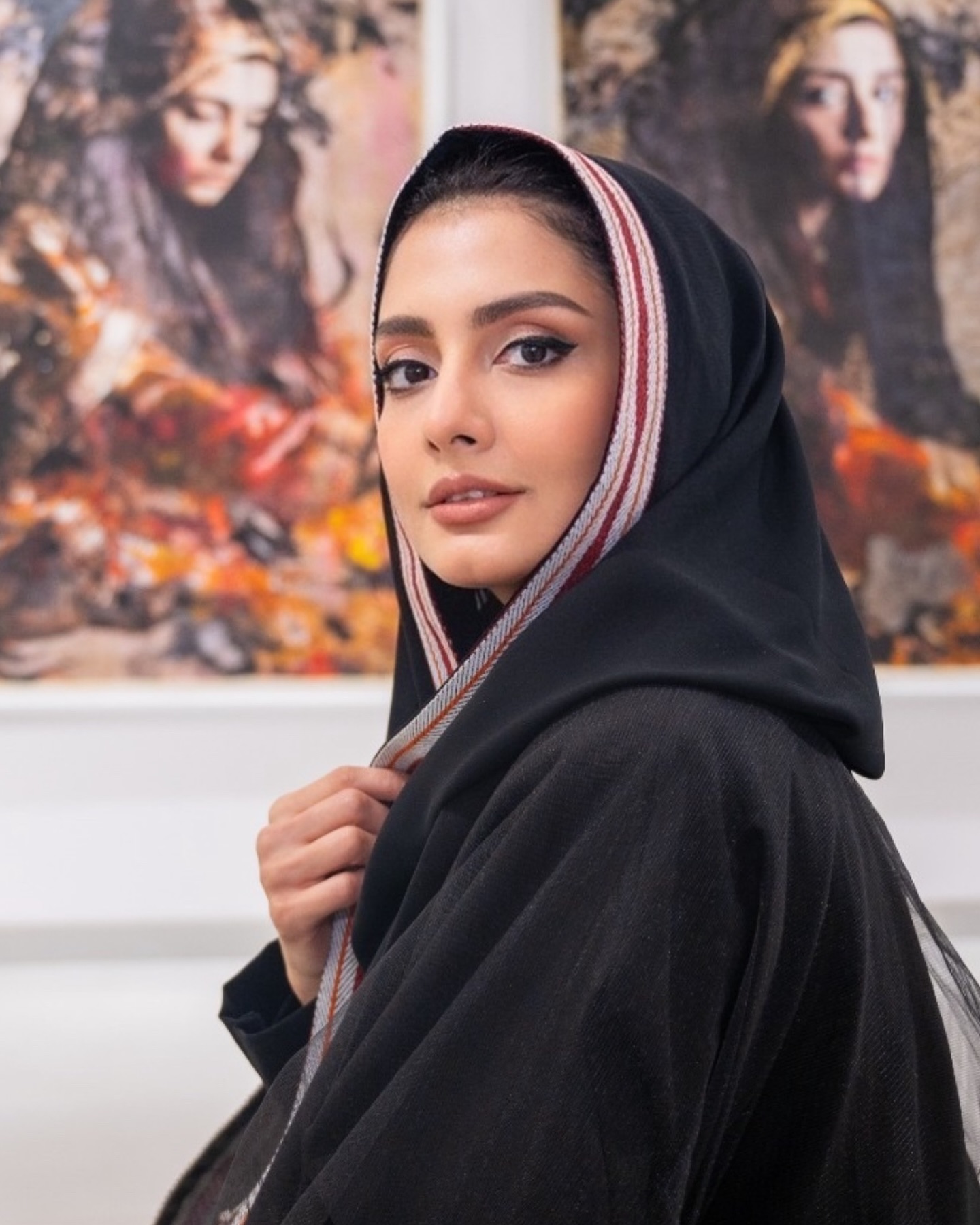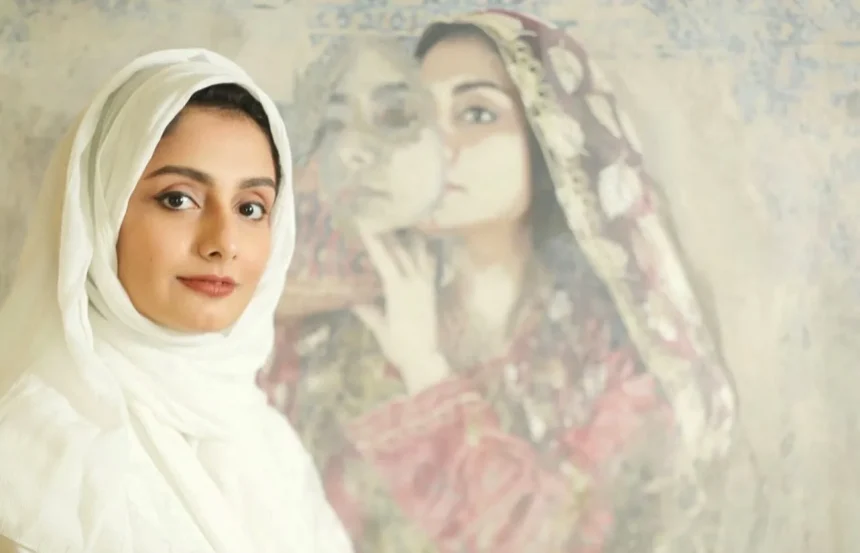A Saudi artist, Fatimah Al-Nemer, has entered the realm of art and expression early on by stepping through the doors of steadfastness and determination from the streets of her hometown of Qatif. She never surrendered to the advocates of isolation and oppression. She had plenty of opportunity to demonstrate her worthiness of having a creative brush and melodic colours during the first Janadriyah and Islamic Art Festivals. 
In the history of expressive arts about Saudi women and their world, which is full of accomplishment, talent, and generosity, her local and international exhibitions hold a significant position. Her modern colour spaces capture the reflections of the Kingdom’s female environment, with its timeless traditions, age-old experiences, and avant-garde and creative spaces.
In all of her works and paintings, she strives to demonstrate that Saudi women can keep up with and embrace human civilisations while maintaining their inherent national identity and diverse local culture. Fatimah Al-Nemer, an artist, granted Arabisk London this exclusive interview.
Interviewed by: Mohsen Hassan
Firstly, how much has the new Saudi openness affected the growth of fine arts abilities among Kingdom women artists, such as yourself?
This resulted in a substantial shift in how the world perceives Saudis and the arts we have to offer. A key component of the modernisation and development procedures embraced by the Kingdom’s Vision 2030 is Saudi creativity expressed through art. As a development tool, art is no longer just a luxury but rather a necessity that is valued by everyone in society, particularly those in positions of senior leadership.
Saudi artists now have access to unprecedented participation and exhibition opportunities with artists from around the world in the most significant international forums, as well as promising artistic opportunities. This has been made possible through mechanisms backed by substantial financial budgets and sponsored by the Fashion Commission, the Ministry of Culture, and the Visual Arts Commission. Consequently, all of this material and moral support has led to the development of our artistic abilities and tools.
Important Saudi women were present in the Arabian Peninsula’s society, as your most recent exhibition in Dubai documented. What key points do you want to make clear to your followers and audience using your brush and colours?
Highlighting the accomplishments, generosity, and giving of the Arabian Peninsula’s pioneering women was the goal of this exhibition. My artistic messages to my audience are communicated through it. These messages tend to explore the metaphysical realms of people, stories, and individuals; they are primarily humanistic, traditional, and narrative.
I can’t claim to be outside these messages’ artistic and expressive framework. Instead, I am positive that I am a part of what my colours and brush embrace. I use them to convey my idea, my vision, and my artistic viewpoint on the things and people in my immediate environment. Nonetheless, the protagonists in my paintings continue to be noticeable and resonate with viewers.
Fatimah Al-Nemer, your mother and art were most important in proving your worth as a human and artist. Is this the truth? What do girls your age require to prove their worth?
Yes, my mother and family were the driving force behind my artistic career, providing me with full support. I always believe that any artist, male or female, requires such motivation and other incentives to give and achieve artistic success.
My mother served as my initial source of inspiration when it came to art and creativity, and she continues to be the primary judge of all of my creations. Regarding my generation’s girls, I believe that the family plays the most essential role in inspiring the artist and igniting their dormant energies; this allows for the release and revitalisation of creativity.
What has Fatimah Al-Nemer gained from your artistic endeavours outside the Kingdom?
These contributions have undoubtedly had a magical effect on your artistic development by exposing you to a wide range of artistic experiences from different cultures, civilisations, and artistic environments in real life.
They encouraged you to investigate the arts, their methods, and their equipment, even though they did not directly aid in your artistic growth. Since they help us understand the arts of the world and share our culture, history, and legacy with the world, we actually still need to increase these contributions in the future.
You gave up drawing and painting for four years due to societal restrictions. What characteristics distinguished this time?
Naturally, it was one of the most challenging times since I was deprived of opportunities to practise my artistic endeavours and, as artists, like all people, can become weak. As a result, I had to stop and study art overseas.
However, because of the outcome of my artistic and human interaction with the supportive environment overseas, I started a new artistic journey in which my creativity was sparked using various tools and materials.
Now, considering the various rights Saudi women are gaining, what do you think of the Kingdom’s women’s community? Which paintings best depict these changes?
Saudi Crown Prince Mohammed bin Salman has been a strong supporter of the women’s community in the Kingdom of Saudi Arabia, across all state institutions. In terms of respect, status, and occupying senior roles, Saudi women are now on par with men. The fact that women in the Kingdom have always been at the forefront of upholding our history, culture, and national identity is simply amazing.
In addition, they provide a strong example of consistency in upholding the true national customs and traditions, which contrasts with the notable deterioration in values, principles, and morals that many societies have noticed.
I always try to capture morally trailblazing women in my paintings, portraying them as admired role models in this evolving world and reassuring everyone that our ideals and principles always make us stronger as women.
What has changed artistically in Fatimah Al-Nemer’s world between your 2009 debut art show in Jordan and your most recent show?
In terms of ideas, experiences, and the narratives they document, I perceive an artistic maturity. I now consider cultural and historical perspectives, as well as qualitative factors that evoke the contributions of Saudi and Arab women and their distinctive manifestations that embrace our heritage and identity, in addition to aesthetic ones, when evaluating my artwork.
I am, after all, not Fatima, but all the women of the country. Regardless, as my experiences grow older, I find myself in desperate need of revitalising, reimagining, and renewing them.
Given your artistic influence on Saudi society, where have you spent your most formative years? What tips would you give to visitors to the Kingdom and those who enjoy travelling?
The Kingdom’s culture and landscape are rich. Some locales talk of a rich and ancient cultural history, while others talk about the style and look of apparel, and still others talk about the goodwill and treatment of others. As an illustration, the Eastern Province’s inhabitants are famous for their love of people and the sea, as well as their appreciation of nature, beauty, warm hospitality, and a wide variety of delectable foods.
There is luxury, modernity, and beauty among the people of Najd and the Central Province. Every area of the Kingdom has its charm and beauty, and I suggest that anyone planning a trip to Saudi Arabia allow at least three months to see the country’s most significant sites. To experience the most exquisite and lively forms of enjoyment, they will require ample time—not a brief one.
What is the biggest objective you have yet to accomplish in your artistic and creative career, to sum up?
I still have big dreams as an artist, and an artist who doesn’t have dreams is already dead. But my main goal for the future is to be able to establish an art museum that will preserve the history and tales of all Saudi and Arab women who have positively impacted our lives. This allows me to document their lives, experiences, and stories through my paintings and creative drawings.

Read more: Nara Saad, a Saudi Visual Artist, told “Arabisk London”: I Believe There is Life in Art